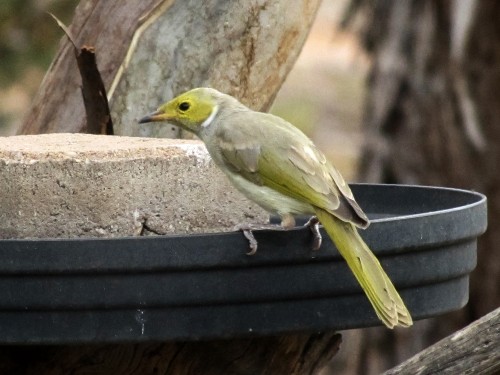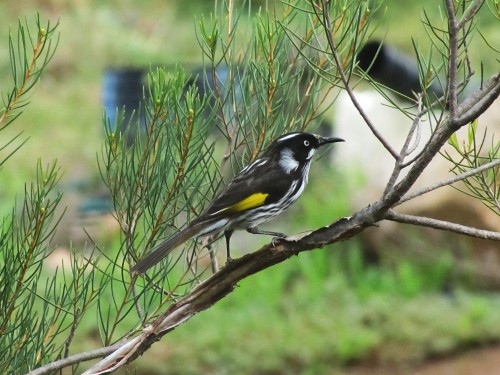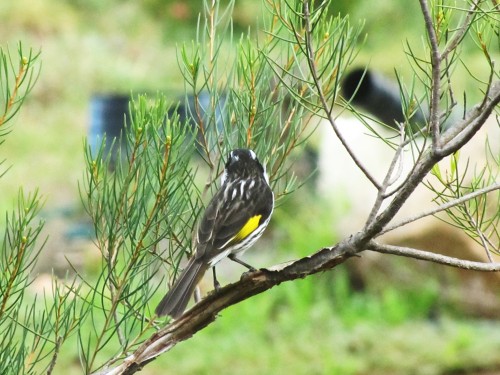White-plumed Honeyeater up close
One of the facilities on my camera (a Canon PowerShot SX20 IS) that I appreciate is the ability to zoom in on birds from a distance. This shot of a White-plumed Honeyeater at one of our bird baths is a case in point. The photo was taken from our sun room at a distance of about 9 metres – I just went outside to step it out!
The zoom allows me to get close up shots like this while keeping a distance from the birds so as not to disturb them too much as they go about their everyday lives. In this case I had the added bonus of being inside the house shooting through a large glass window overlooking the garden. The room acts a bit like a bird hide.
While this is not a brilliant photo – the focus could be sharper – I still find it satisfying to get up lose and personal with our bird life.
New Holland Honeyeaters
Sometimes everything just works really well when taking photos of birds.
Here is a case in point.
I looked out of the window from my office and saw this New Holland Honeyeater perched on one of the branches of a bush in the garden. I grabbed my camera and clicked; I was quite pleased with the result.
Sometimes you do win them.
I have a new camera

Canon Powershot SX20IS
Most of the photos on this site have been taken with a Canon Powershot S2IS. It has been a good workhorse camera for me over the last five and a bit years. The results shown on this site speak for themselves. The S2 has been superseded by several models since its release but it was perfectly adequate for my needs. I bought the camera specifically for a trek in the Himalayas and the Everest region in January 2006 (read about it here.)
The Canon Powershot S2 IS features 12x zoom and 5 megapixels. The 12x zoom has been particularly useful for taking bird photos, but often I was left wanting just a little more. A recent set of circumstances has led me to upgrade to the Canon Powershot SX 20 IS (see photo above). This is a run-out model, being superseded by the Powershot Sx 35 IS. I knew about this new model but reviews I read were not all that complimentary, so I dismissed that model, despite the extra zoom. It was also double the price.
The one I bought was actually on sale for less than half its listed RRP. Not only have I scored a bargain, my first impressions are very favourable. The 20x zoom is great and at 12.1 megapixels the photos should also be impressive. Sure, you can get cameras that are far more impressive, greater zoom, more features, more megapixels and so on, but you’d pay a lot more than I have.
I’d love a top of the range digital SLR with all the bells and whistles, but I carry enough gear when birding; I don’t want to have to carry several lenses, tripod and so on. It’s a choice I’ve made; lightness and convenience won the day, as well as price.
I still have quite a few photos to share here taken with the old camera but those taken with the new one should start appearing here soon. Some of the first photos taken with the new camera have appeared on my blog Trevor’s Travels here and here and here. One of the first bird photos taken with the camera appears below.
Good birding.
Some simple bird photography rules
A few days ago I was sitting out in the lovely winter sunshine trying to recover from my recent bout of flu. Our back veranda is generally out of the wind and a very pleasant spot to take in a little snoozing in the sunshine. It was one of those rare days we’ve had recently, what with all the rain and showery weather we have been having for a change. We can’t say we are out of the drought yet, but the signs are encouraging.
While slumbering in the sun I was aware of a bird of prey calling nearby. That certainly woke me up. What looked and sounded like a Brown Falcon was circling low overhead. Several of the local resident Australian Magpies were vigorously attacking this poor creature. In a matter of seconds it had flown off to a safer location.
I do not yet have a photo of a Brown Falcon. During those 10-15 seconds it was circling overhead I most certainly would have been able to get several good shots of the underwing markings. Alas – no camera in my hand or within easy reach. When I did go inside to get my camera I found that the batteries were flat.
Two Simple Rules:
- Always have your camera handy.
- Check to see that the camera batteries are charged.
Happy birding.
Good bird photos
Photography seems to run in the family. My wife takes photos of plants and flowers, I take photos of scenery, birds, animals and flowers, my daughter takes photos of people and places and my son takes photos of scenery, buildings, animals and now has a growing interest in birds.
In recent times he has added some interesting new equipment to his camera gear. This has enabled him to take some great photos. Here are some links to some recent great shots.
- Munro Park – including shots of a White-faced Heron catching a fish.
- Taronga Park Zoo – including a wonderful photo of a Red-tailed Black Cockatoo.
- Lane Cove National Park for lunch – this features an amazing photo of a Sulphur-crested Cockatoo and another of the back of my head (not together).



